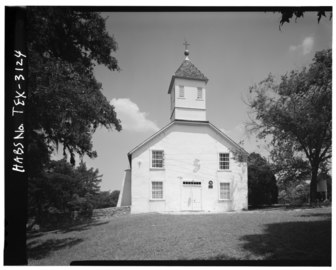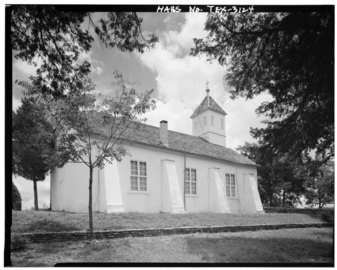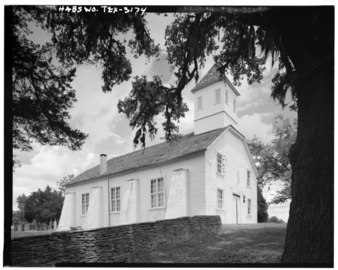
Round Top is a town in Fayette County, Texas, United States. The population was 90 at the 2010 census.

The Basilica of Saints Peter and Paul in Lewiston, Maine, also known as Ss. Peter and Paul Church, is a church which is a part of the Roman Catholic Diocese of Portland.

Saints Peter and Paul Jesuit Church is a Roman Catholic church located at 629 East Jefferson Avenue in Detroit, Michigan. It is the oldest existing church in the city of Detroit, and was listed on the National Register of Historic Places and designated a Michigan State Historic Site in 1971.

The United Methodist Church and Parsonage are a historic United Methodist church and its adjacent historic parsonage located on a 2-acre tract on the corner of East Main Street and Smith Avenue in Mount Kisco, Westchester County, New York. The New Castle Methodist Episcopal Church was designed by J. King in the Carpenter Gothic style of architecture and built in 1868 by Edward Dauchey, while the parsonage, designed in the Victorian style of architecture, was built in 1871. Today the church is known as the United Methodist Church of Mt. Kisco. On November 4, 1982, both the church building and the parsonage were listed on the National Register of Historic Places as a single filing.

The First Baptist Church of Ossining is located in the center of the village of Ossining, New York, United States. It is a brick building in the Gothic Revival architectural style with a tall wooden steeple built in the 1870s, one of Ossining's most prominent landmarks. In 1973 it was listed on the National Register of Historic Places. Sixteen years later, in 1989, it was included as a contributing property to the Downtown Ossining Historic District when it was listed on the Register.
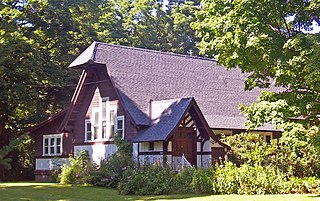
The former Trinity Episcopal Church is located on NY 23B in Claverack, New York, United States. It is a Shingle Style church building from the early 20th century.

The Reformed Dutch Church of Claverack is located on New York State Route 9H at the north end of the hamlet of Claverack, New York, United States. It is a brick church built in the mid-18th century and renovated and expanded twice in the 19th, reaching its present form in 1879. The congregation was founded in 1716.

Gethsemane Lutheran Church is a historic Lutheran church in downtown Austin, Texas. Designated as a Recorded Texas Historic Landmark and listed on the National Register of Historic Places, the building currently holds offices of the Texas Historical Commission.
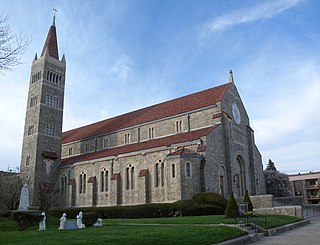
St. Vincent de Paul Catholic Church is located in Bayonne, Hudson County, New Jersey, United States. It is an active parish of the Archdiocese of Newark, in Deanery 13. It is noted for its historic parish church, which was added to the National Register of Historic Places on August 24, 2011, for its significance in architecture and art.

St. John's Lutheran Church is a historic Lutheran church in Huron County, Michigan. It is located at 4527 Second St. in Port Hope, Michigan. The Victorian Gothic style church was built in 1899. It was added to the National Register in 1987.

Fayetteville Historic District is located in Fayetteville, Texas. The small town of Fayetteville is in rural south east central Texas midway between Houston and Austin. The oldest extant building in the district was constructed in 1853. The historic district represents most of the development within town boundaries as indicated by street signs, the boundaries have been drawn to exclude some areas in town occupied primarily by construction from after 1958. The area of the district is 153.5 acres (62.1 ha) and includes 345 properties considered historical and largely intact. An additional 137 properties within district boundaries are not considered for contribution to the historic status of the district. It was added to the National Register of Historic Places (NRHP) on July 10, 2008.

The Cathedral Church of St. Peter is an Episcopal cathedral in St. Petersburg, Florida, United States. It is the seat of the Diocese of Southwest Florida. In 2004 it was included as a contributing property in the Downtown St. Petersburg Historic District on the National Register of Historic Places.

Hebron Church is a mid-19th-century Lutheran church in Intermont, Hampshire County, in the U.S. state of West Virginia. Hebron Church was founded in 1786 by German settlers in the Cacapon River Valley, making it the first Lutheran church west of the Shenandoah Valley. The congregation worshiped in a log church, which initially served both Lutheran and Reformed denominations. Its congregation was originally German-speaking; the church's documents and religious services were in German until 1821, when records and sermons transitioned to English.
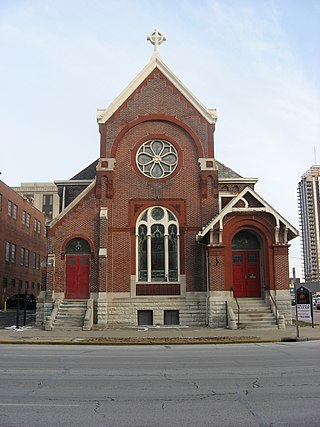
Mount Pisgah Lutheran Church, also known in its early years as the First Lutheran Church and First English Lutheran Church and more recently as The Sanctuary on Penn, is located at 701 North Pennsylvania Street in downtown Indianapolis, Indiana. The historic church was built by the city's first Lutheran congregation, which organized in 1837, and was its third house of worship. The former church, whose present-day name is The Sanctuary on Penn, is operated as a for-profit event venue.

Main Building is the central administration building of St. Edward's University in Austin, Texas, and formerly also of St. Edward's High School. First completed in 1888 and rebuilt after a fire in 1903, Main Building has been listed on the National Register of Historic Places since 1973, along with adjacent Holy Cross Hall.

Castroville Historic District is a United States historic district in Castroville, Texas. It includes the oldest parts of the city of Castroville and contains twelve designated contributing properties, including a Texas State Historic Site and numerous Recorded Texas Historic Landmarks. The district was listed on the National Register of Historic Places in 1970.
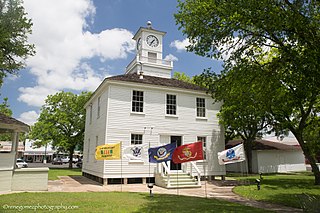
Fayetteville County Precinct No. 2 Courthouse is a historic building located in Fayetteville, Texas.
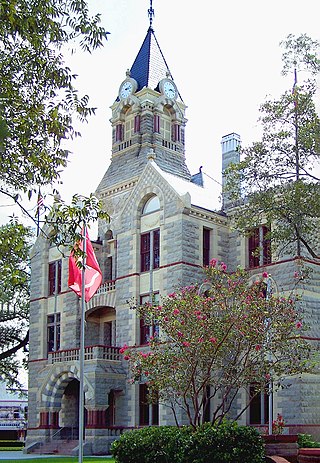
The Fayette County Courthouse and the Fayette County Jail are two historic buildings in La Grange, Texas. The courthouse was designed by James Riely Gordon and built in 1891 by Martin, Byrne and Johnston. The jail was built earlier in 1881 by Fritz Schulte and designed by John Andrewartha and James Wahrenberger. Both buildings were added to the National Register of Historic Places (NRHP) as a single listing on January 23, 1975. and designated a Texas State Antiquities Landmark on January 1, 1981 by the Texas Historical Commission (THC). Texas historical marker number 12627 erected in 2001 commemorates the courthouse's status as a Recorded Texas Historic Landmark, marker no. 18757 placed in 2017 does likewise for the jail. On January 16, 2001 both buildings were designated and recorded in the NRHP as contributing properties to the Fayette County Courthouse Square Historic District.

The Fayette County Courthouse Square Historic District in La Grange, Texas is a historic district roughly bounded by Main, Lafayette, Franklin, Colorado, Jefferson, Washington, and Crockett Streets. It was listed on the National Register of Historic Places on January 16, 2001. Two notable buildings in the district are the Fayette County Courthouse and Jail. Forty–seven buildings, three structures and four objects were identified as contributing to the historic nature of the district.

All Saints' Episcopal Church is a historic Episcopal parish church in Austin, Texas, United States. Built in 1899 on the edge of the University of Texas at Austin campus, the church has long-standing connections with the university's student body and faculty. The chapel was a project of Episcopal Bishop George Herbert Kinsolving, whose crypt is located under the church. It has been designated as a City of Austin Historic Landmark since 1980 and a Recorded Texas Historic Landmark since 2014, and it was listed on the National Register of Historic Places in 2015.



